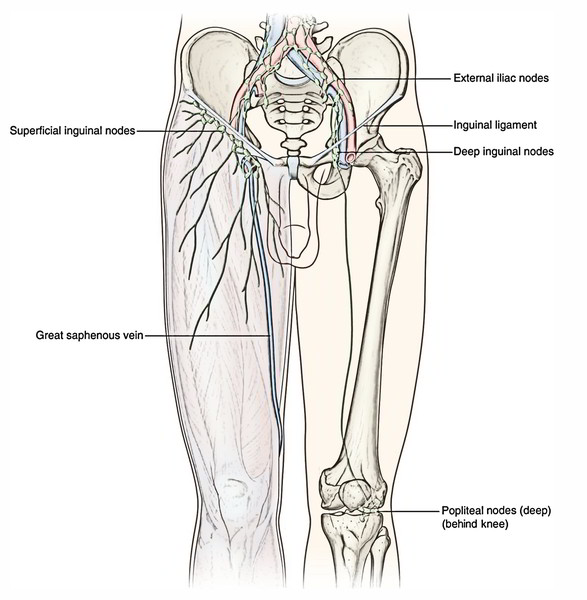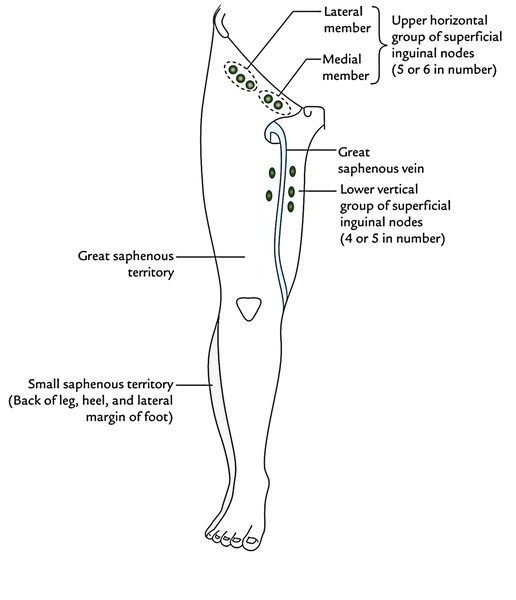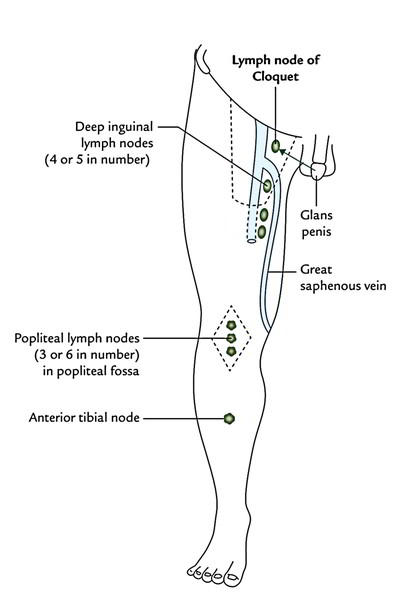The inflammatory lesions of limb cause painful enlargement of the lymph nodes meanwhile blockage of lymphatics by microfilaral parasites makes huge edema of the lower limb, that is the reason why the understanding of lymphatic drainage system has great clinical importance.
Inguinal lymph nodes is the place where most of the lymph from lower limb is drained either directly or indirectly through popliteal and anterior tibial nodes. But it is the internal iliac nodes where deep structures of gluteal region and upper part of the back of the thigh are emptied.
Lymph Nodes
The lymph nodes are classified into 2 types: superficial and deep.
- Superficial lymph nodes contain the superficial inguinal nodes.
- Deep lymph nodes contain the deep inguinal nodes, popliteal nodes, and anterior tibial nodes.
Superficial Lymph Nodes
Superficial Inguinal Nodes
All these are existing in the superficial fascia of the inguinal region. They can be ordered in 2 groups: upper and lower, resembling the letter “T”.
The upper horizontal group includes 5 or 6 nodes, which be located below the inguinal ligament. The lateral members of upper group (2 or 3 nodes) receive afferent from:
- Gluteal region.
- Upper part of the lateral side of the thigh.
- Flank and rear of the abdominal wall below the umbilical plane.
- The medial members of the upper group receive afferent from:
- Subcutaneous tissue of the anterior abdominal wall below the umbilicus.
- Penis consisting of prepuce and scrotum in male, vulva and vagina below the hymen in female.
- Perineum and lower part of the anal canal below the pectinate line.
- Few lymphatics from the superolateral angle of uterus which accompany the round ligament of uterus.
The lower vertical group is composed of 4 or 5 nodes. They can be set along either side of the terminal part of great saphenous vein. They receive afferent from the skin and fasciae of the majority of the lower limb (great saphenous land), with the exception of from buttock, which drain into upper lateral group and the short saphenous land, which drain into popliteal nodes.
The efferents from all the superficial inguinal nodes pierce the cribriform fascia and terminate into the deep inguinal nodes.
Deep Lymph Nodes
Deep Inguinal Lymph Nodes
These are about 4 to 5 in number, and is located on the medial side of the upper part of the femoral vein in the femoral triangle. The most proximal node of the group (gland of Cloquet or Rosenmuller) is located in the femoral canal. These nodes receive afferents from: (a) the superficial inguinal nodes, (b) popliteal nodes, (c) glans of penis/clitoris, and (d) deep lymphatics of the lower limb accompanying femoral vessels.
Their efferent vessels from the deep inguinal lymph nodes drain into the external iliac nodes after piercing the femoral septum, which shuts the femoral ring.
Popliteal Lymph Nodes
The popliteal lymph nodes (about 3 to 6 in number) be located embedded in the popliteal pad of fat near the conclusion of the small saphenous vein; 1 node is located between the popliteal artery and the oblique popliteal ligament. The popliteal nodes receive afferents from: (a) the land of small saphenous vein (i.e., lateral side of the foot, heel, and lateral half of the rear of leg), (b) deep parts of the leg, running along the anterior and posterior tibial vessels, andthe knee joint.
The efferents from the popliteal nodes run along the popliteal and femoral vessels to terminate into the deep inguinal nodes.
The popliteal lymph nodes are exceptional in the meaning they are the only deep nodes, which receive both the superficial and deep lymph vessels.
Anterior Tibial Lymph Node
The anterior tibial lymph node is an inconstant node seen along the upper part of anterior tibial artery. When present, it gets the afferents from the anterior compartment of the leg, and its efferents enter the popliteal nodes.
Lymphatics
Like lymph nodes, the lymph vessels of lower limb are also classified into 2 groups: superficial and deep.
Superficial Lymphatics
The superficial lymphatics are bigger and much more numerous compared to the deep lymphatics. They run in the superficial fascia. They create 2 primary streams: (a) majority of them (the main stream) follow the great saphenous vein, and drain in the lower vertical group of superficial inguinal lymph nodes, and (b) the remaining 1 (accessory stream) follows the small saphenous vein, and drains into the popliteal lymph nodes.
Deep Lymphatics
The deep lymphatics are smaller and fewer compared to the superficial lymphatics. They drain all the structures lyingdeep to the deep fascia. They run along the principal blood vessels of the lower limb and drain into the deep inguinal nodes, either directly or indirectly via the popliteal nodes.
The deep lymphatics from the gluteal region and upper part of the back of thigh accompany the gluteal vessels and drain into the internal iliac nodes.
Clinical Significance
- Elephantiasis: The lymph vessels of the lower limb in many cases are obstructed, especially in the endemic regions, by the microfilarial parassites (Wuchereria bancrofti). This causes enormous edema of the lower limb creating a clinical condition named elephantiasis. In this illness, there’s hypertrophy of the skin and subcutaneous tissue to an uncommon percentage.
- Enlargement of the inguinal lymph nodes: It’s thecommonest cause of swelling in the subinguinal region. The common reasons for enlargement of these lymph nodes is infection, boil or abscess in the drainage area. The other causes are filariasis, Hodgkin’s disease, etc
. The enlarged inguinal nodes ought to be identified from ectopic testis, femoral hernia, and psoas abscess.




 (59 votes, average: 4.46 out of 5)
(59 votes, average: 4.46 out of 5)